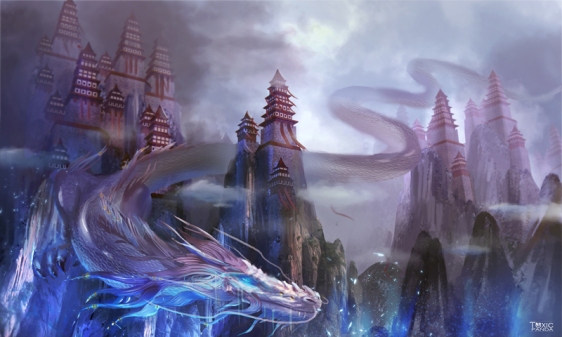When talking of “balance” within artwork, does the term not only refer to the “weights” of various areas within the artwork (such as it’s ability to pull on your eyes); but also to the techniques that have been used to construct that artwork. Within this Fantasy Realm, do I find the use of three such artist’s techniques, that also happen to be in balance – with each other:

A Chinese Water Dragon – that Snakes through Perspective and Layer!
First: comes the artist’s use of layering. This Dragon’s head is on a layer by itself – right at the very front (the foreground). As the Dragon’s neck begins to fade, do we encounter interaction with the foremost castle spire (it passes behind it). As the Dragon’s tail begins to “snake”, do we encounter interaction with the aft/right-most castle spires (it both overlaps, and passes behind them). And yet, is this Dragon’s tail not quite as simple as that – for at each “dragon level”, has the artist decided to match the lighting in that area (as to avoid an unbalanced scene). Second: comes the artist’s use of perspective. This Eastern Castle makes use of a three-point perspective (the third vanishing point being found – when you extend a line upwards from the apex of each tower). If we also extend that line downwards, do we find that these towers share a relationship with their foundations: it’s hard to imagine the towers being “at home” on any other rock formation! And yet, is this three-point perspective not as simple as that. The third vanishing point, has been used to “pull you into the scene” – particularly upwards (whilst also interacting with the Dragon’s tail [especially in terms of scaling]). I also feel that there’s a relationship between the Dragon, and the other two vanishing points. The left-most vanishing point, causes the left-most castle “opening faces” to be at the same “angle” as the Dragon’s neck. The effect is further enhanced, by the use of similar shading in this area (both the Dragon’s neck, and the castle’s “opening faces” go from dark to light, with the light being intensified on the top-right). The right-most vanishing point, causes the right-most castle “uniform faces” to be at the same “angle” as the Dragon’s face (achieved through clever shading on the whitened rock [just above that cloud]). Thus, is this three-point perspective, very powerful indeed! Third: comes the artist’s interpretation of the Fantasy itself. When I look at this Dragon, do I think of the Element of Water 🙂 The artist has chosen their colours wisely – the Dragon’s aquamarine is of Water. The artist has chosen their details cleverly – the Dragon’s scales are of Water (akin to a fish’s scales). The artist has also chosen their highlights carefully – the collection of “white flecks” (towards the bottom of the artwork), are as if they are Water Spray (especially on the bottom right). When these three techniques are taken together – do I find: that the Element of Water, Snakes through these Towers, Cascading to the Depths, Amongst the Hills, Bringing the Magic of Water – to this Fantasy Scene 🙂

